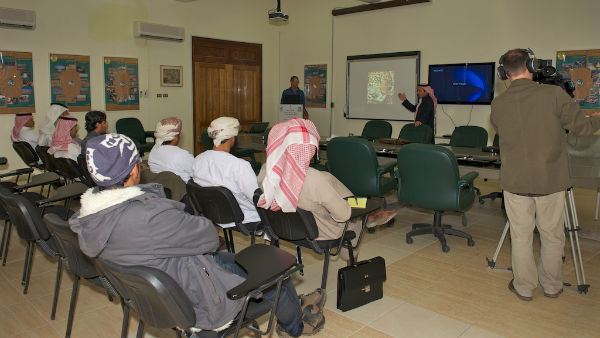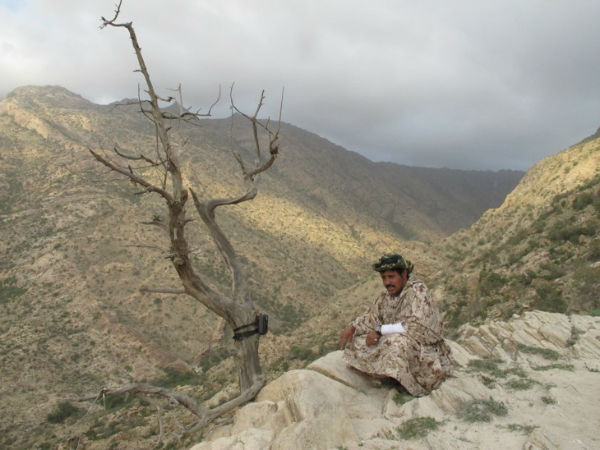In January, Cape Leopard Trust founding member and CEO, Quinton Martins, was invited to conduct an Arabian leopard ecology and conservation workshop by the Saudi Wildlife Authority based at the National Wildlife Research Centre (NWRC) in Taif, Saudi Arabia.
The Arabian leopard Panthera pardus nimr is classified as Critically Endangered according to the IUCN Red Data List (2008). A resident population of this rare and endangered subspecies is known to exist in Oman and Yemen, but is unknown for Saudi Arabia. Recent surveys suggest total population estimates of 200 for the entire Arabian Peninsula may be an overestimate. Since 1999, records of leopard in Saudi Arabia have yet to be substantiated apart from 4 incidents when animals were poisoned as a result of livestock depredation events. Leopards are threatened in areas such as Saudi Arabia where conserved areas suitable for leopards are small and perturbation of habitat extensive due to human settlement and infrastructural development.
The similarity of leopards in the Western Cape mountains to the Arabian leopard suggests it to be a good comparative subject. These equally small leopards also occur in low densities exhibiting some of the largest home ranges recorded for the species while inhabiting similar rugged, mountainous terrain. As with large carnivores on a global level, leopards in the Cape experience similar threats to leopards in Saudi Arabia.
The aim of the ARABIAN LEOPARD ECOLOGY AND CONSERVATION WORKSHOP in 2013, was to:
(i) share information on the ecology and conservation of leopards in the Cape mountains, South Africa;
(ii) focus on detection methods to establish leopard presence in Saudi Arabia;
(iii) design a suitable survey to determine population size;
(iv) detail trapping and collaring methods; and
(v) assess the conservation status and concerns of the Arabian leopard.
To begin with, a workshop including participants from Taif University, NWRC and leopard research projects in Oman was held to review knowledge on leopard ecology and local conservation issues. Quinton presented on his work in the Cape as well as leopard ecology and conservation on a broader level, while local researchers provided an update on the most recent Arabian leopard work.

Figure 2 Quinton being introduced at the NWRC. Photo courtesy of NWRC photo library
Thereafter the team headed south in search of the leopard in the mountains near Al Namas. This spectacular area is characterised by large, deeply incised and very steep mountains reaching over 3000m in height. Juniper forests are found in the mist covered peaks, while further below, rough and arid scrub persists much like mountains we see in the Northern Cape or Namibia – just much bigger. Hiking was tough, but invigorating as Quinton was soon to find signs of new and rare species such the Arabian wolf and striped hyaena. Massive troops of Hamadryas baboons were prevalent in the area, sometimes numbering over 600 in a group. Sadly, no definitive signs of leopards were seen.

Figure 3. Hamadryas baboons near Taif.
In order to assess whether leopards still existed, sixteen camera stations were established in suitable leopard areas. Wadis (kloofs or drainage lines) can be very prominent routes used by male leopards in rugged mountain areas, and thus were the focal point for camera trapping. Sites were first identified using Google Earth, and then visited on foot to confirm suitability. Cameras covered a large area providing a better opportunity to capture more than one individual, while the survey was aimed at leopard detection only. Once leopard presence is established, a more thorough attempt at estimating population size will be attempted. Recommendations were made that future surveys begin in the southern most part of their range, closest to the known source population in Yemen, working systematically north.

Figure 4. Camera set on a prominent ridge line halfway up the slope of the valley.
Threats most likely responsible for the general paucity of prey and predators were: poaching, hunting, road construction, human encroachment and habitation, overgrazing, feral dogs, poisons, road-kills and livestock depredation.
Quinton reported back saying this was one of the most interesting and rewarding trips as well as one of the most fascinating cultural experiences.
















